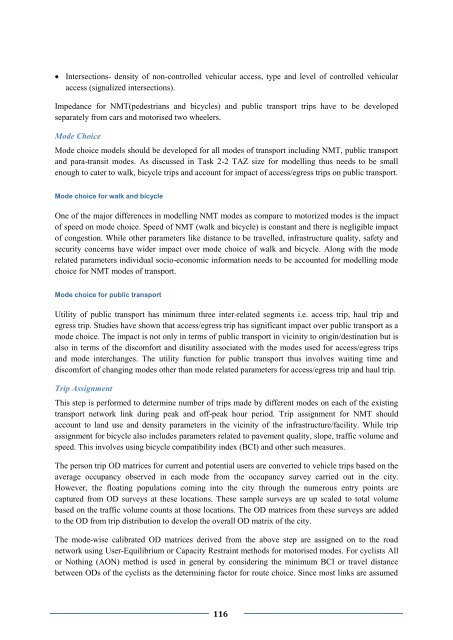Toolkits for Urban Transport Development - UNEP
Toolkits for Urban Transport Development - UNEP
Toolkits for Urban Transport Development - UNEP
Create successful ePaper yourself
Turn your PDF publications into a flip-book with our unique Google optimized e-Paper software.
Intersections- density of non-controlled vehicular access, type and level of controlled vehicular<br />
access (signalized intersections).<br />
Impedance <strong>for</strong> NMT(pedestrians and bicycles) and public transport trips have to be developed<br />
separately from cars and motorised two wheelers.<br />
Mode Choice<br />
Mode choice models should be developed <strong>for</strong> all modes of transport including NMT, public transport<br />
and para-transit modes. As discussed in Task 2-2 TAZ size <strong>for</strong> modelling thus needs to be small<br />
enough to cater to walk, bicycle trips and account <strong>for</strong> impact of access/egress trips on public transport.<br />
Mode choice <strong>for</strong> walk and bicycle<br />
One of the major differences in modelling NMT modes as compare to motorized modes is the impact<br />
of speed on mode choice. Speed of NMT (walk and bicycle) is constant and there is negligible impact<br />
of congestion. While other parameters like distance to be travelled, infrastructure quality, safety and<br />
security concerns have wider impact over mode choice of walk and bicycle. Along with the mode<br />
related parameters individual socio-economic in<strong>for</strong>mation needs to be accounted <strong>for</strong> modelling mode<br />
choice <strong>for</strong> NMT modes of transport.<br />
Mode choice <strong>for</strong> public transport<br />
Utility of public transport has minimum three inter-related segments i.e. access trip, haul trip and<br />
egress trip. Studies have shown that access/egress trip has significant impact over public transport as a<br />
mode choice. The impact is not only in terms of public transport in vicinity to origin/destination but is<br />
also in terms of the discom<strong>for</strong>t and disutility associated with the modes used <strong>for</strong> access/egress trips<br />
and mode interchanges. The utility function <strong>for</strong> public transport thus involves waiting time and<br />
discom<strong>for</strong>t of changing modes other than mode related parameters <strong>for</strong> access/egress trip and haul trip.<br />
Trip Assignment<br />
This step is per<strong>for</strong>med to determine number of trips made by different modes on each of the existing<br />
transport network link during peak and off-peak hour period. Trip assignment <strong>for</strong> NMT should<br />
account to land use and density parameters in the vicinity of the infrastructure/facility. While trip<br />
assignment <strong>for</strong> bicycle also includes parameters related to pavement quality, slope, traffic volume and<br />
speed. This involves using bicycle compatibility index (BCI) and other such measures.<br />
The person trip OD matrices <strong>for</strong> current and potential users are converted to vehicle trips based on the<br />
average occupancy observed in each mode from the occupancy survey carried out in the city.<br />
However, the floating populations coming into the city through the numerous entry points are<br />
captured from OD surveys at these locations. These sample surveys are up scaled to total volume<br />
based on the traffic volume counts at those locations. The OD matrices from these surveys are added<br />
to the OD from trip distribution to develop the overall OD matrix of the city.<br />
The mode-wise calibrated OD matrices derived from the above step are assigned on to the road<br />
network using User-Equilibrium or Capacity Restraint methods <strong>for</strong> motorised modes. For cyclists All<br />
or Nothing (AON) method is used in general by considering the minimum BCI or travel distance<br />
between ODs of the cyclists as the determining factor <strong>for</strong> route choice. Since most links are assumed<br />
116
















